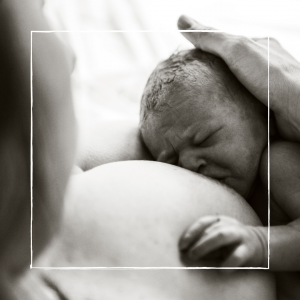
Giving Birth as an Expat in Spain – Insights from a Doula

Whether you’re new to Spain or have been here for years living la vida loca (or you know, working and studying and such) chances are you haven’t given much thought to what pregnancy and birth in Spain is like. You’ve seen all those kids out at the terrazas into the wee hours of the night all summer long, but what’s the process like having kids here?
While we’re not experts on this topic ourselves, we’ve found someone who definitely is: Madison Kannapel, an American doula based in Madrid whose passion is supporting pregnant, birthing, and postpartum women. Madison runs Madoula and offers labor, birth, and postpartum care in person or online. Whatever kind of birth you’d like to have, Madison provides information, resources and support of your family’s unique decisions. She’s thus the perfect person to ask about all our giving birth questions!
Withour further ado, here are Madison’s insights on giving birth in Spain…
When You Find Out You’re Pregnant:
Woohoo! As soon as you’ve peed on that stick or missed your period, the first thing most women in Spain do is call their GP (médico de cabecera) in the public system. Your medico de cabecera will usually give you a urine pregnancy test, though not always, and then schedule your appointments with both the gynecologist and your midwife at your usual clinic (centro de salud). Most prenatal appointments will be with a midwife except for certain appointments that will be with an obstetrician (tocólogo). The midwife and obstetrician you see in the public system will typically not be the midwife or obstetrician who delivers the baby in the hospital.
In the public system, you may receive a little booklet which is referred to as a Carné or Cartilla de la Embarazada depending on what region you’re in.
 If you have private healthcare, you can go ahead and schedule an appointment with your usual OB/GYN (tocólogo/ginecólogo). In the private system, the most common method is for all prenatal appointments to be with an OB/GYN. This OB/GYN may work in a hospital and be the one by your side when baby is born, but not always. This varies from place to place, so the best way to find out how it works with your preferred OB/GYN is by asking early on in the pregnancy who will be at the birth.
If you have private healthcare, you can go ahead and schedule an appointment with your usual OB/GYN (tocólogo/ginecólogo). In the private system, the most common method is for all prenatal appointments to be with an OB/GYN. This OB/GYN may work in a hospital and be the one by your side when baby is born, but not always. This varies from place to place, so the best way to find out how it works with your preferred OB/GYN is by asking early on in the pregnancy who will be at the birth.
Good to know: Nearly any pregnant woman in Spain qualifies for prenatal and birth care in the public healthcare system. However, there are a few requirements women must meet if they do not already have a social security healthcard. First, the woman must have resided in Spain for more than 90 days and have a padrón municipal (municipal registration) that proves it. It can get complicated quickly, so here is more information about the rights of pregnant women and children (in Spanish).
Good to know: Prenatal, birth and postpartum care is primarily midwife-led in the public system, in contrast to the US (where I’m from) which is OB/GYN led with nurses on the labor ward during labor. In Spain, the midwife is usually the one to deliver the baby and the obstetrician (tocólogo) is mostly called in for higher risk births and situations.
 Tests and Appointments:
Tests and Appointments:
Throughout your pregnancy (in either public or private systems) you’ll be offered the following tests:
-
10-13 weeks: A blood and urine test (cribado) around 12 weeks which will check for things like if you’ve had toxoplasmosis before (apparently if you have, you can eat jamón during your pregnancy and if not, no ham for you), your blood type, vitamin and iron levels, sexually transmitted infections and genetic abnormalities.
-
10-13 weeks: An ultrasound/sonogram (ecografía) at around 12 weeks to take a look at baby’s health and to evaluate for soft markers for Down Syndrome.
-
Additional Testing: If the combined results from the blood, urine, and ultrasound suggest a high-risk pregnancy, you will be offered an amniocentesis to get more information about your baby.
-
Second Trimester: Blood test, urine test, and a glucose test. The glucose test is a 1-hour test (curva de glucosa) in which you’ll drink a sugary drink and have your blood drawn before and one hour after drinking it. If this test indicates higher glucose levels than normal, you will be offered a 3-hour glucose test. This test is used to determine gestational diabetes.
-
20 weeks: Ultrasound called the Anatomy Scan (ecografía de anatomía o ecografía de las 20 semanas) which measures the baby’s growth, checks for abnormalities, and makes sure the placenta is working properly.
-
Third Trimester: Blood and urine test to check for infection, anemia, etc.
-
34 Weeks: An ultrasound to check on baby and confirm if baby is head-down or not. If you’re unsure about baby’s position when you go into labor, you can ask them to check this via ultrasound at the hospital too.
-
36 Weeks: A vaginal (and sometimes anal depending on the provider) swab that checks for the presence of Group B Strep (estreptococos grupo B) which is a normal bacteria that comes and goes in your digestive tract. If Group B Strep is identified, your care provider will recommend that you receive antibiotics during labor every four hours.
-
40 Weeks: Around this time is when the public system begins monitoring the baby with fetal monitoring (monitores). This will be done at the hospital you’ve chosen to give birth at and is about 30 minutes of monitoring the baby’s heartbeat and whether or not you are having productive contractions.
 In the private system you may notice the following differences from the public system:
In the private system you may notice the following differences from the public system:
-
5-9 weeks: First ultrasound (ecografía) to confirm pregnancy and, if possible, hear baby’s heartbeat.
-
Some private practices offer an ultrasound at every prenatal appointment. These are short scans that give the doctor a glimpse at how baby is doing.
-
Private doctors might also begin monitores sooner than in the public system – from around 36 weeks onward, once a week.
Good to know: During pregnancy, your body continues being yours and you have the right to accept or deny any test offered or recommended to you. It’s your decision how many tests you would like to have and which ones are important to you. You can also ask for additional testing if anything ever feels wrong or off. Your rights are protected in the Spanish healthcare system by law – La Ley de Autonomía del Paciente.
Giving Birth:
37 weeks to 42 weeks is considered a full-term pregnancy and babies can be born spontaneously anywhere in that range. In Spain, doctors in both the public and private systems offer/encourage induction of labor around 41 weeks if labor has not yet started spontaneously yet.
Childbirth Prep: Both public and private systems offer childbirth prep, but I’ve never found one in English. To prepare for giving birth, it’s a great idea to complement your birth prep course through the public or private sector with a more in depth look at what you want your birth experience to be like. This can be done with a doula, like myself, who can help you pinpoint your birth values, understand your expectations for birth, and help you craft a birth plan that is 100% aligned with your unique needs and desires.
 Choosing Where to Give Birth
Choosing Where to Give Birth
If you live outside of a major city, your options may feel limited to the one or two hospitals nearby or a homebirth with a qualified midwife. However, you always have the option of changing hospitals at any time of your pregnancy and even showing up at any public maternity ER (urgencias de maternidad) while in labor. Also, some women choose to travel to a bigger city to find a care provider and hospital that more closely aligns to their desires for a positive birth experience.
Good to know: Homebirth is not available or covered by private or public insurance of any kind (that I’m aware of, but if you’ve heard of this please let me know all about it!) however, there are home birth teams of midwives that practice throughout Spain. Midwives in Spain must complete rigorous training: 4 years of nursing university then 3 years of residency/specialization so you can count on them being professional and capable.
When choosing where to give birth, you may want to consider:
1. Do you feel in agreement with the protocol and overall view of birth at this particular hospital?
2. Is having a neonatal or adult ICU important to you and does this hospital have one or both?
3. How do birth stories of others who’ve given birth there make you feel? To find birth stories you can check out the Birth Story Library I have on my website or, if you speak Spanish, check out the El Parto Es Nuestro Facebook group and use the search bar to find stories of birth at hospitals in your area.
4. Do you feel you will be respected and empowered by healthcare providers during your birth experience and have an overall positive experience?
5. Does the hospital have the furnishings you’d like (for example, a birth tub, yoga ball, cloth hanging from the ceiling, birthing stool, etc)?
6. What kind of pain relief would you prefer to use and is it available there?
7. How many birth support people am I allowed to have according to hospital policy? Most Spanish hospitals allow only one support person, but many women prefer to have two support people like their partner and their mother or their partner and a doula, etc.
 Having a healthy mom and baby is of course the #1 desired outcome, but it is not the only thing that is important. It’s also possible to have a very positive experience and have an empowering memory of your birth – a memory which positive or negative will be with you for your entire life. Planning for a positive wedding or travel experience is seen as normal and valued in our society, so too should be planning for a positive birth experience.
Having a healthy mom and baby is of course the #1 desired outcome, but it is not the only thing that is important. It’s also possible to have a very positive experience and have an empowering memory of your birth – a memory which positive or negative will be with you for your entire life. Planning for a positive wedding or travel experience is seen as normal and valued in our society, so too should be planning for a positive birth experience.
A positive birth experience is not woo-woo or just for some people – anyone can have a positive birth experience because it depends on much more than the actual events of birth – it depends on expectations, support people, and how you’re made to feel while giving birth. Choosing a hospital that aligns with your needs is a great step to increasing the likelihood of having that positive experience.
Bonus tip: The Spanish ministry of health actually provides a Birth Plan Template that you can find here. You can fill it out with your preferences and take it with you to the hospital you give birth at.

One last thing to consider: Preparing for and giving birth is not the only thing to get ready for, though it is often what gets the most focus. It’s also valuable to learn about and prepare for the postpartum period known as the Fourth Trimester – those 12 weeks following birth that are a time of adaptation and learning for both parents and the new baby. What happens when baby is born and how will you be cared for during this time of physical recovery and emotional changes? To learn more about postpartum – consider having a Postpartum Prep session with me online (or in person in Madrid).
Thank you so much to Madison for this in-depth and informative article! If you have further or questions or want to get in touch with Madison for more information, resources, and support for your unique birthing experience you can connect with her through her website, her Facebook group: New & Expecting Moms in Spain, on Instagram, and on Facebook.





One Comment
Pingback: